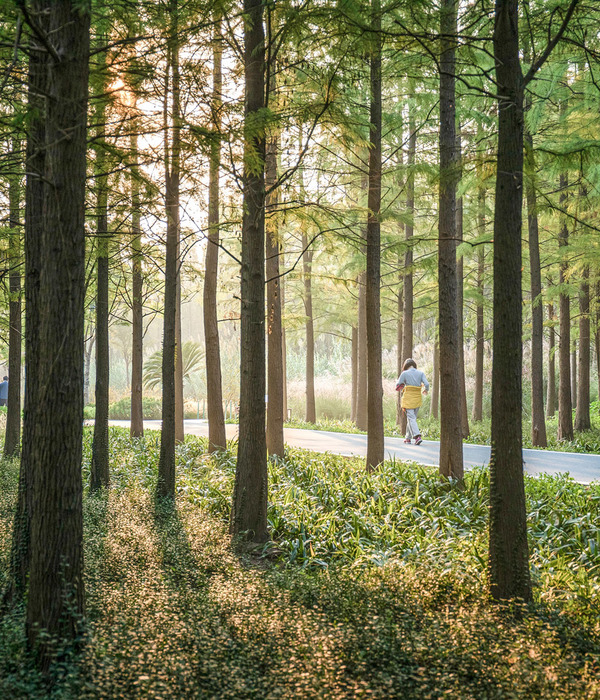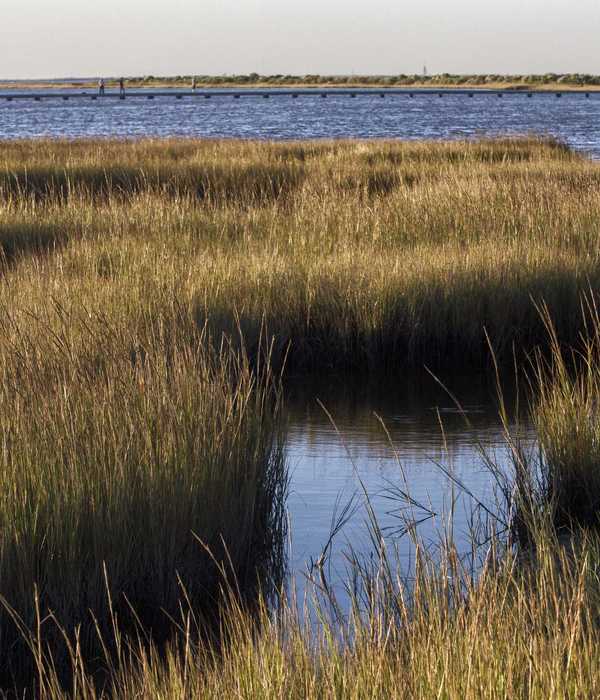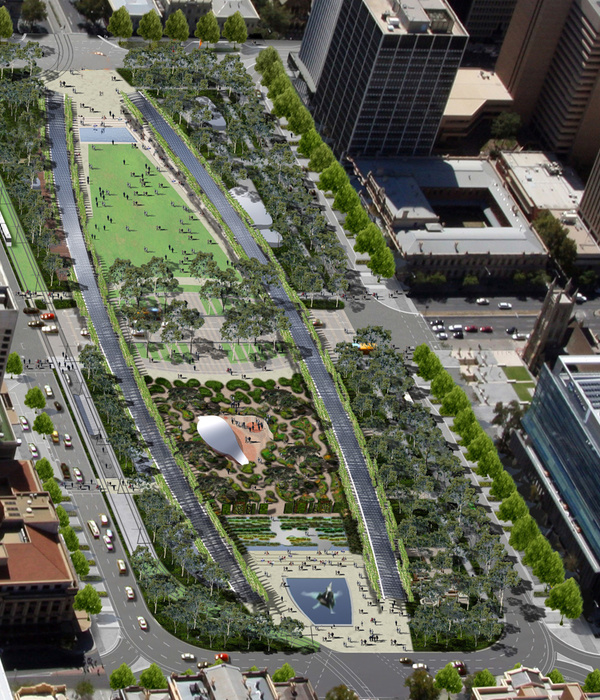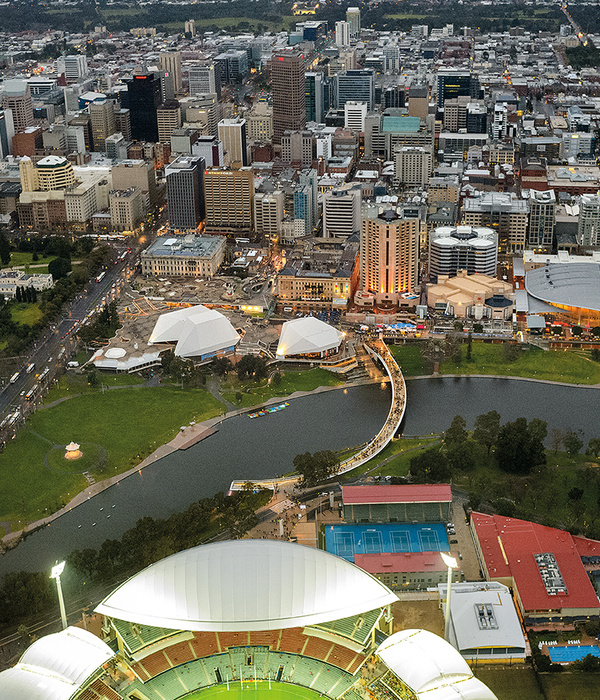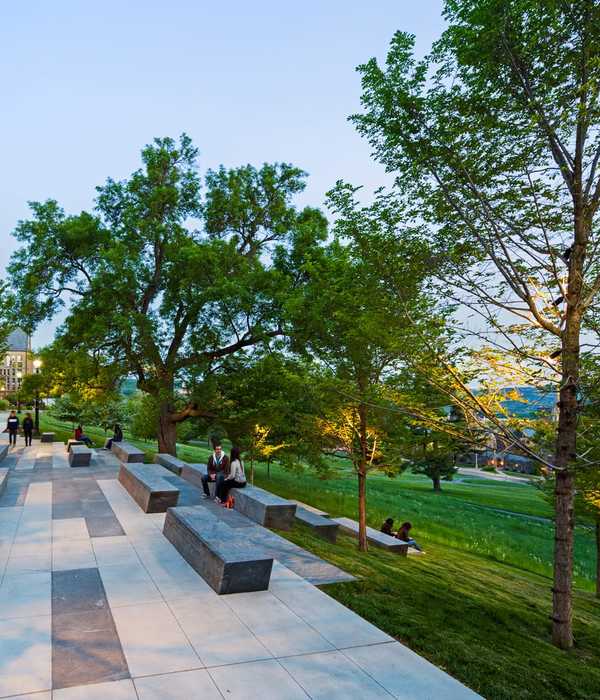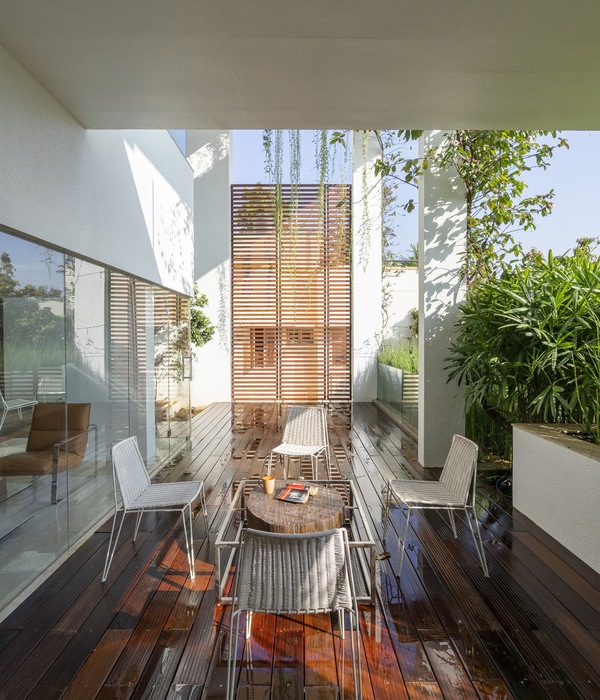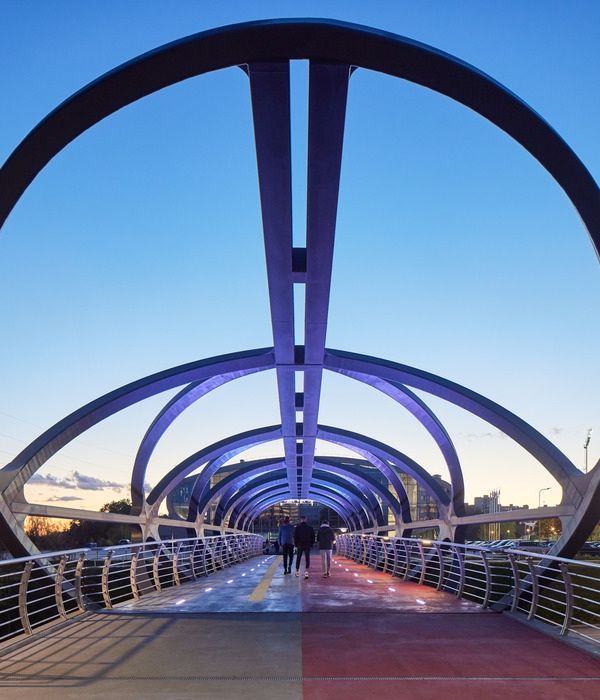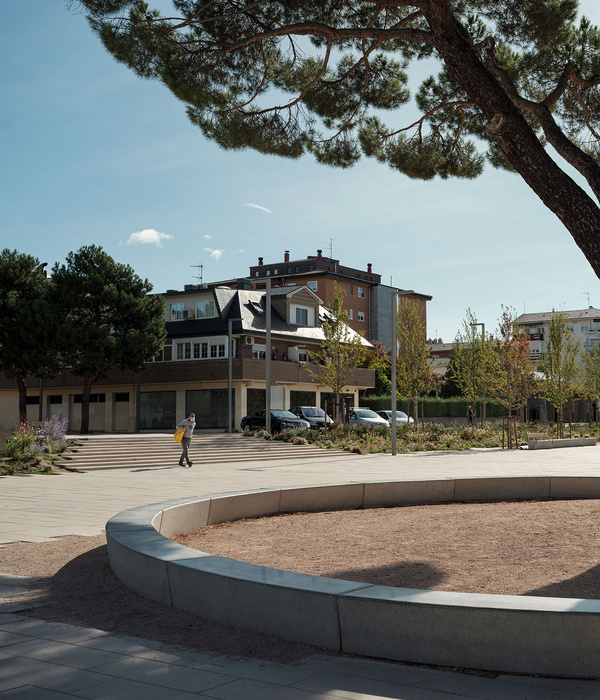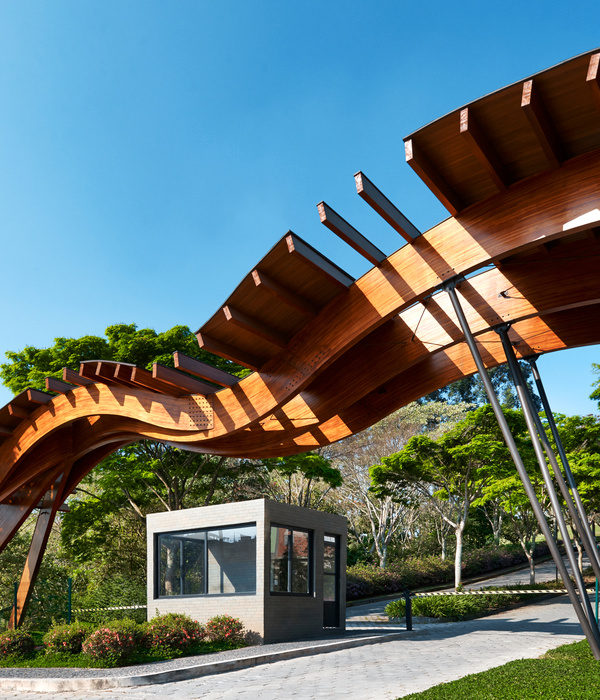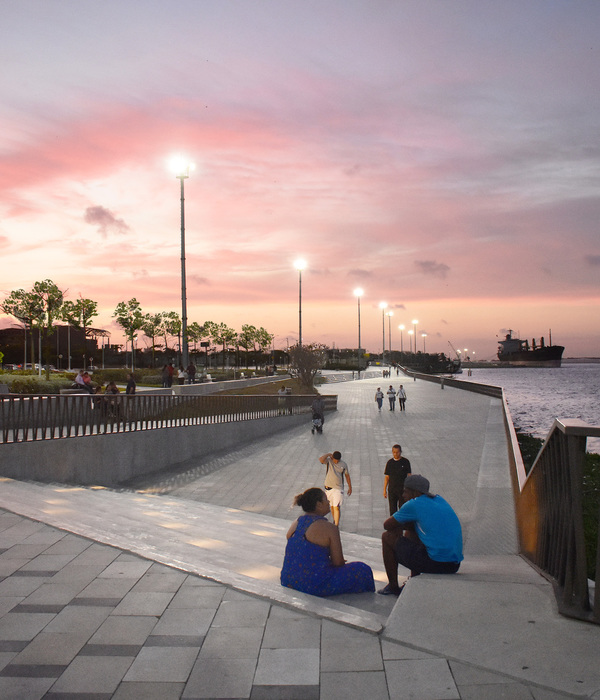首创性和竞争性描述
Initiative And Competition Description
二百周年的构想和挑战
The Bicentennial Initiative / The Challenge
本次竞赛的主旨是通过设计,来探讨利马这座城市应该与其历史遗迹和干旱景观建立何种关系。该国际竞赛提倡以帕查卡马克的总体规划为基础,而这一总体规划,也正是由联合国教科文组织(UNESCO)和COPESCO National Plan所发起的。该总体规划要求在帕查卡马克的历史遗迹区的周边设计一个线性公园。这个未来的线性公园应该为该地区的一系列新建项目,即国家博物馆(National Museum ,MUNA)、Pachacamac遗址博物馆(Pachacamac Site Museum)和Urpi Wachaq湿地恢复倡议(Urpi Wachaq initiative for the recovery of wetlands)等,提供更大的凝聚力和连通性。此外,本项目还希望在市郊的非正式扩建区内限定出一个缓冲区。作为秘鲁最重要的遗产区之一,也作为利马景观设计领域中的重要范例,这座规模宏大的公园将进一步巩固和加强帕查卡马克保护区(Pachacamac Sanctuary)。因此,本次竞赛鼓励所有的参赛队伍在设计中考虑场地的文化及其生态环境和社会环境的复杂性,从而实现一次前所未有的大融合。
▼入口轴测图,the entrances axon
The competition was an invitation to reflect on the relationship that Lima should have with its archaeological heritage and arid landscape. The International competition initiative was based on the Pachacamac Master Plan —a document sponsored by UNESCO and the COPESCO National Plan. This document calls for the design of a linear park along the perimeter of the Pachacamac archaeological site. The future park is expected to give greater cohesion and connectivity to recent projects in the area; namely, the National Museum (MUNA), the Pachacamac Site Museum, and the Urpi Wachaq initiative for the recovery of wetlands. The park initiative is also essential to define a buffer from the informal extension of the city’s outskirts. A park of this scale will consolidate the Pachacamac Sanctuary as one of the most important heritage sites in Peru as well as a key precedent for landscape design in Lima. The competition encouraged participants to consider the cultural, ecological and social complexities of the site to achieve such integration.
▼回收公园中心,the recycling park hub
▼矿物质海岸沿岸,along the mineral shore
▼海滨平台,theterrace on the ocean
▼平台和观景台系统,the system of terraces and belvederes
项目描述
Project Description
将帕查卡马克公园打造为一个当代的神话
The Park Of Pachacamac As Contemporary Myth
“沙漠并不是一个广袤无垠的荒芜之地。它是一座神圣的纪念碑,被时间的灰尘和沙砾所覆盖着。在它的周围,富饶的海岸线就像一个薄薄的保护层。这么长的一条线围成了一个圆圈,在时间的冲刷下,宏大的记忆被塑造成未来。”
«The immense void was not a desert.
It was a sacred monument, covered by time with dust and sand.
Around it, as a thin protective membrane, run a fertile shoreline.
A line so long it became a circle, for a time so vast memory became future
总体规划平面,the overall plan
帕查卡马克公园的神话讲述了富饶的海岸线是如何逐步建设而成的,在这里,随着时间的推移,原有的无效城市资源逐渐转变为生态系统。公园未来的海岸将是一个柔软且可移动的边界,它由不同的物质组成,平行设置然后相互叠加,当然也可能随意混合…随后,这些物质再分开;然后不断地与突然出现的空间阻碍相互适应,再将它们逐渐纳入自己的麾下。公园的神话将景观的产生视为一个集体过程,而新的组合将为公园的共同实施和管理提供可能性。这个过程通过循环式的变形,对材料物质和社会文化资源进行了重新组合。由此,一种新型的、广阔且富有成效的城市景观便被创造了出来。与传统意义上的神话故事一样,在长期的时间范围内,景观都有能力在一个主要的连贯目标中引导集体能量。
The Myth of the Pachacamac park narrates the progressive construction of a fertile shore, where the inert recycled ressources of the city are transformed through time into living ecosystems. The future shores of the sanctuary will be a soft and moving threshold : composed of different substances, running parallel to then superpose, maybe hybridize … and then separate again ; adapting to sudden obstacles and reabsorbing them. The park’s myth conceives landscape production as a collective Process where new alliances allow a shared implementation and management of the park. This process recombines material and socio-cultural resources, in a circular metamorphic effort. A new kind of extensive and productive urban landscapes emerges.Like traditional mythology, Landscape has the capacity to channel collective energies in a major coherent objective, on a long term time horizon.
▼局部平面图,the partial plan
▼剖面图,sections
设计概念 – 原则与平面
Schemes – PRINCIPIA And PLAN
神话的创造 – 原则
Grounding The Myth – Principia
帕查卡马克公园的神话以四个主要的景观原则为基础进行设计和叙述,这有助于形成一种能够设计空间限定和工程实施的整体方法。这些原则可以被用于时间和空间的构建,分别是:P 1 – 虚空间是一座纪念碑,公园则是一层薄薄的保护结构。
P 2 – 公园是城市和生态系统的连接器。
P 3 – 公园组织并提出了一种新型的资源循环方式。
P 4 – 公园循环以一种程式化的顺序进行组织。
The Pachacamac park myth is grounded on four key landscape Principia which foster a holistic approach to design definition and construction. These Principia inform a palimpsest for action which is conceived to be adaptable through time and space:P 1 – The void is a monument / the park is a thin protective membrane.
P 2 – The park is an urban & ecosystemic connector.
P 3 – The park organizes and stages a new approach to resources circularity.
P 4 – The park loop is organized in programmatic sequences.
▼原则分析图,principia diagram
设计概念 – 渐变文法
Schemes – GRADIENT GRAMMAR
渐变规则– 文法
Gradient Strategy– Grammar
这个公园边界线设计的总体概念是梯度,整合了三个主要的景观条件,分别是:“生产的景观(Productive landscape)”、“环境带(Milieus strip)”以及“矿物质海岸(Mineral shore)”。每个景观组成部分的深度和重要性都能够适应公园环路的特定条件。关键节点处的景观规模非常宏大,与此相对应,其他区域的路径系统则被设计成较为轻薄且简约的感觉。
1. “生产景观”从第一阶段起便沿着现有的城市结构建立,不仅促进了城市服务,更为未来公园的构建提供了前提条件。这一部分的景观包括:水景园区、植物园区和城市农业地带等。
2. “环境带”是公园内部的瑰宝:这里有一系列丰富多样的环境体验,而这些环境体验还与公园的不同文化空间、体育空间和开放性空间等相关联。在公园的西北部分,轻度干旱区域、中度干旱区域和极度干旱区域的环境特征暴露无遗。在公园的西部,环境带的重要性则被进一步地突显了出来——它变成了一个当地的植物园,不仅有助于组成国家博物馆的框架,还使得该地区能够与沿海的生态系统在未来产生联系。而在环境带西北侧的Tello区内,通过组织人们的行为活动,形成了一个城市园艺试验场,该园艺试验场包含着LAB实验空间、城市规模尺度的植物园区和高品质的开放式矿产空间。
3. “矿物质海岸”则是该遗址区的最终界限。这个景观带高度较低,但面积十分广袤,且充满着矿物质,是一个极简主义风格的砾石回收和水平墙体系统,将公园与采矿场、积尘区和绿地区拉开了一定的距离。这个广阔地带的设置是大都市范围下建筑资源的循环式经济的范例,同时还将吸引附近地区的工人。这样,就可以建造一整个海岸线,而不仅仅是一堵墙。
The overall concept of the thereshold is that of a gradient, integrating three major landscape conditions: the « Productive landscape », the « Milieus strip », the « Mineral shore ». The depth and the importance of each of these landscape constituents adapt to specific conditions along the park loop. Larger and richer in terms of landscape offer in key programmatic areas; thinner and minimalist along other paths.
1. The «Productive landscape » is installed from phase 1 along the existing urban fabric fostering services to the city and preparing the becoming of the future park. Program: water treatment, vegetal nurseries, urban farming.
2. The «Milieus strip» is the inner nectar of the park: a loop of rich and diversified environnemental experiences linked to the different cultural, sportive and open-space programs of the park. In the northern-west part the characterizing milieus of medium, low and non-irrigation arid areas are found. In the western part of the site, the Milieus strip gains all its importance, becoming an ethno-botanical garden, this allows to securize and organize the framing of the MUNA museum and to prepare the future relation of the site with the coastal ecosystem. On the north-western side as in the Tello district the strip organizes citizen’s action becoming the experimenting field for urban gardening – LAB, urban scale vegetal nurseries and mineral qualified open spaces.
3. The «Mineral Shore» is the ultimate threshold with the heritage site. Low, vast and mineral, it is a minimalist system of recycled gravels and horizontal walls putting a distance between excavation sites, dust and greener areas. The setting of this wide field is conceived to be a demonstration of a circular economy of building resources at a metropolitan scale and will engage workers from the nearby district. Rather than building a wall, we can build a shore!
渐变规则文法分析图,gradients grammar
设计概念 – 资源分享
Schemes – RESOURCES DIAGRAM
整体实施过程
A Holistic Implementation Process
项目所面临的所有来自社会和经济上的挑战都要求建筑师找到一种针对“建成意义”和“资源回收再利用”的新战略。因此,这将会是一个实验性的项目,用以测试的强调分散管理的新协议的可行性。
The social and economic challenge the project represents demands to find new strategies for actorial implication and resources re-usage and recycling. The project will be an experimental field to put to test new protocols for decentralized management.
集体故事 – 涉及当地社区
A Collective Story – Implicating The Local Community
场地逐渐转变为一个集体空间,当地社区对此作出了巨大的贡献。在项目开发的每个阶段,基地的转型都将涉及到当地的社区。这对于社会文化自由的构建和经济的升级来说,将是一个千载难逢的好机会。
对于一个项目来说,在项目伊始,限定空间就是十分重要的,因此,在本项目中,建筑师设计了一个空间,这个空间可以充当信息的集散地、联合创始会议的举办地、甚至是有主题的公民辩论活动的承办场所。开放式的空间规划、有关城市农业和城市工作的教学活动、以及施工主动性的提案等,都将是居民生活中宝贵的主题。值得一提的是,居民必须学会表达自己的想法,同时抓住这个机会,积极参与基地的转型。
Local communities contribution will be essential in order to recognize the transformation of the site as a collective space. Local communities will be implied in the transformation of the site in each phase of the development. This will be an occasion for socio-cultural empowerment and for an economic upgrading.
Since from the beginning it will be important to define a space, a "House of the project" where information will be given, meetings can be taken in order to host associative initiatives, and organize the citizen debate around concrete objectives. Open-space programming, pedagogical programs concerning urban agriculture or work and construction initiatives are topics on which the word of inhabitants will be precious and valuable. Inhabitants will have to express themself, and in the meanwhile participate to the economic opportunity offered by the site’s transformation.
▼水体资源分析图,resources diagram –water
循环协议– 暗示新型回收计划中的经济参与者
Circular Protocols– Implying Economic Actors On New Recycling Initiatives
如今,建筑业已经消耗了50%的可使用型自然资源,同时产生的废弃物垃圾也占世界废弃垃圾总量的50%。自房地产热潮以来,利马每年都要产生近300万吨的建筑和拆迁废物,而其中70%以上的废物最终都被遗弃到了非法的荒漠之中,污染了大片的海岸和公共空间。值得人们关注的是,距离公园不远处,就有一处作为非法荒地的海岸线(从Barlovento海滩到Lurin河口),长度超过8公里。
通过接收、分类和处理施工和拆除所产生的无用废物,其中80%的材料都可以被重新用于构建公园中的新建建筑物、地板处理和城市家具等。根据其特定的材料成分和尺寸大小,建筑师们可以轻松地对这些无用的废物进行加工和组织,以便在现场进行大量的材料再评估和再利用。资源的再利用也为当地的设计概念提供了一种地域型思路,同时更有助于在设计过程中将大范围的经济参与者纳入其中。
Today the construction industry consumes 50% of available natural resources and produces 50% of total waste generated in the world. Lima, since the construction boom, produces almost 3 million tons of construction and demolition waste every year and more than 70% of it ends-up in illegal wastelands, polluting the seacoast and public spaces. Not so far from the park, more than 8 km of the sea cost (from Barlovento beach to the mouth of Lurin river) has been an illegal wasteland for many years.
By receiving, sorting and processing construction and demolition inert waste, 80% of it can be reused to produce the new buildings, floor treatments, and urban furniture of the park. Inert waste can be easily processed and organized on the basis of its specific material composition and size for a large revalorization and reuse on site. The reuse of resources gives a territorial intelligence to local conception and help imply a wide network of economic actors in the design process.
▼材料资源分析图,resources diagram – material
设计概念 – 时间视野
Schemes – TIME HORIZONS
进化的视野–步入神话之境
Evolutive Horizons– Stepping Into The Myth
随着时间的推进,本项目的设计战略将一步步地构建出属于这座公园的整体面貌,即“神话”。为此,在本项目中,建筑师提议将时间作为一系列连贯的“演化视野(Evolutive Horizons)”。每个阶段都有一个景观主角和适应场地的新型空间条件,从而限定出每一个景观视野。此外,每个景观视野都有一定的自主性,可以随时对项目进程进行测试和调整。同时,每个景观视野也都定义出一个特定的场地平衡状态,从而加深了公园场地与其周围城市之间的关系。
The « Myth », the « big picture » of the park, is the resultant of a step by step strategy through time. We propose to read time as a succession of coherent « Evolutive Horizons ». Each Horizon comes to life through the emergence of a landscape protagonist and of a new spatial condition for the site. Each Horizon is somewhat authonomous, allowing to test and adapt the level of ambition. Each Horizon defines a specific state of balance to the site and brings the relation with the surrounding city one step further.
▼时间视野分析图,time horizons diagrams
Place: LIMA – Peru – Pachacamac sanctuary
Client: 2021 – Bicentennial Projects Initiative, in association with the Municipality of Lima and the Peruvian Ministry of Culture
Process: International Landscape design competition
(restrained to team leader offices with built or ongoing projects)Number of entries: 116 delivered projects ; more than 200 offices participating ; approx. 20 countries represented
Result: Finalist and Honorary Mention
Program: Linear park; House of the project; Pedagogical greenhouses; Ethno-bothanical garden; Ateliers Huaquita; Tree nursery; Urban gardening; recycling Hub
Areas: Pachacamac Sanctuary – 465 Ha, Linear Park – approx. 72 Ha
Team Leaders : KH STUDIO – delli Ponti & Novielli – Building Strong Stories, architecture urbanisme paysage
Associates: Elaine Sanchez & Diego Morales Bolognesi – YDEA colectivo; Rodrigo Apolaya – APU colectivo
Knowledge Hub – consultants:Matteo Di Stanislao – Landscape designer at KH STUDIO
Carmen Felipe Morales – Agronomist and Professor at Universidad Nacional Agraria
Roger Mori – Director of CICLO – recycle to build
Gabriela Ferrando – Licensed Archeologist and Master in Comunication PUCP
IMAGES CREDITS: KH STUDIO – delli Ponti & Novielli – architecture urbanisme paysage with Elaine Sanchez; Diego Morales Bolognesi; Rodrigo Apolaya
{{item.text_origin}}

